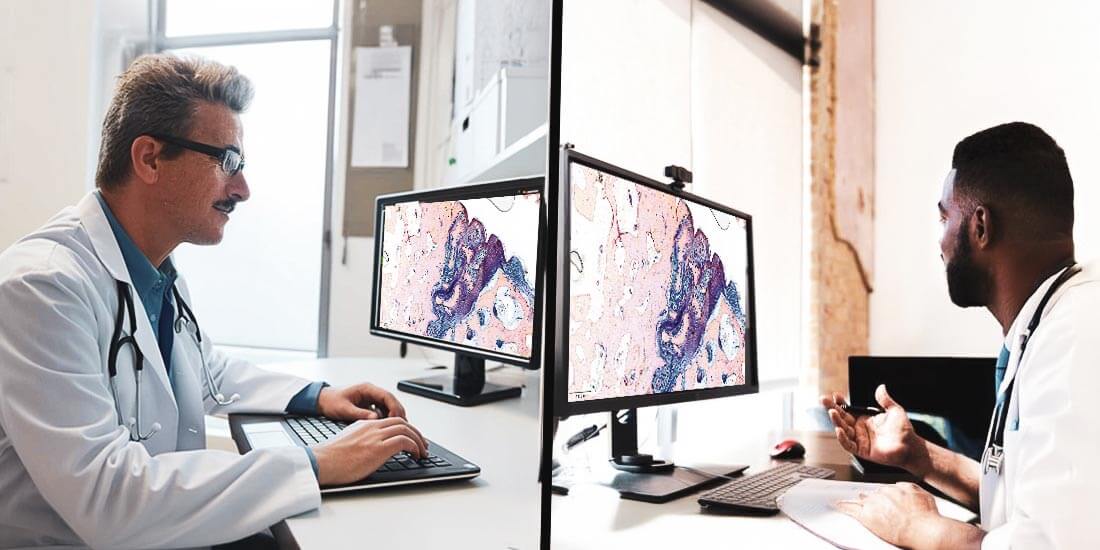Synopsis
Many pathology laboratories and institutions are evaluating the need to switch to virtual microscopy. This shift from traditional microscopy to virtual microscopy requires a thorough evaluation of many important aspects, such as cost-benefit analysis, financial sustainability, training requirements, and operational readiness. However, a critical factor that is often overlooked by organizations and conglomerates is why it is necessary to switch to virtual microscopy. What are the specific requirements for your laboratory and institute? Virtual microscopy is not only about the financial challenges and additional training aspects. There is more to it. This article will explore the importance of switching to virtual microscopy.
The Shift to Virtual Microscopy
The microscope has always been an indispensable tool in medicine, biology, and a variety of scientific disciplines. It has redefined the understanding of life and disease. It has enabled scientists and other medical professionals to explore the complex world of cells, tissues, and microorganisms. For decades, traditional microscopes were the standard means of studying these microscopic structures. However, as technology has evolved, there has been a paradigm shift in the world of microscopy – a shift to virtual microscopy.
Why Embracing Virtual Microscopy Offers Compelling Solutions?
Virtual microscopy is an advanced technology that digitizes entire microscope slides. It allows researchers and medical professionals to view high-resolution digital images on a screen, eliminating the need to manually examine physical slides under a microscope. The technology itself relies on advanced imaging equipment, including high-quality scanners and software to capture and store detailed images of tissue samples. The virtual microscope offers a variety of advantages and has proven to be an effective tool for transferring educational knowledge and an assessment tool for measuring patient care outcomes.
Accessibility and Collaboration
One of the biggest advantages of virtual microscopy is the instant access to microscope specimens. Working with physical slides can lead to transportation risks, as slides can be easily damaged during transportation. Virtual microscopy technology removes these barriers and allows people anywhere in the world to collaborate and work together. Virtual microscopy technology facilitates global collaboration, speeds up research, and promotes knowledge sharing, leading to better outcomes and better treatments for patients.
Preservation of Samples
Traditional microscopy techniques require manual handling of slides, which can lead to wear and tear over time. In addition, storing many slides in a lab or workspace requires significant storage space and maintenance. Virtual microscopy solves these issues; it allows digital copies of samples to be stored indefinitely. This saves physical space and ensures that samples remain undamaged for future research and reference.
Enhanced Teaching and Learning
In education, virtual microscopy is changing the way histology and pathology are taught. The use of traditional microscopes limits the number of students who can view slides at the same time. On the contrary, virtual microscopes display high-resolution images to an entire class and allow remote access for flexible learning.
Why Is Telepathology Important?
Telepathology is a fast-growing field that uses virtual microscopy to enable remote diagnosis and consultation. It is particularly important in remote and underserved areas where access to specialized pathology services may be limited. With telepathology, you can view digital sections from anywhere in the world, providing timely diagnosis and consultation, ultimately improving patient care and outcomes.
Advanced Analytics and Machine Learning
Advanced analytical techniques and machine learning algorithms integrate well with virtual microscopy. The integration allows you to analyze huge data sets from digital slides more efficiently and accurately than ever before. Machine learning models can identify patterns, abnormalities, and potential biomarkers in images faster, helping to diagnose diseases, discover medications, and create personalized healthcare plans faster.
Save Time and Costs
Traditional microscopy can be very time-consuming as it often requires manual examination of multiple sections and the need to identify specific areas of interest. Virtual microscopy simplifies the process by allowing you to quickly view and annotate digital sections. Increased efficiency reduces labor costs and speeds up research activities, benefiting both academia and the healthcare industry.
Archiving and Documentation
In healthcare and research, accurate documentation is critical. Virtual microscopy simplifies the process of archiving and documenting results. You can create comprehensive digital archives of slides with annotations and descriptions. This ensures data integrity and makes it easier to retrieve and review historical cases, helping to improve research reproducibility and clinical excellence.
Conclusion
The move to virtual microscopy offers significant advantages for both diagnosis and research purposes. The benefits of virtual microscopy are numerous, whether in an urban hospital with state-of-the-art equipment or a geographic area with limited resources. Virtual microscopy ensures unrestricted access to samples, as they are securely stored in digital format. This eliminates risks associated with shipping physical slides. In addition, the move to virtual microscopy facilitates seamless collaboration with other experts, fostering rapid second opinions that can save lives in critical situations. Although additional training may be needed to fully adopt this practice, its benefits, including enhanced teaching and learning, make this barrier easy to overcome.











